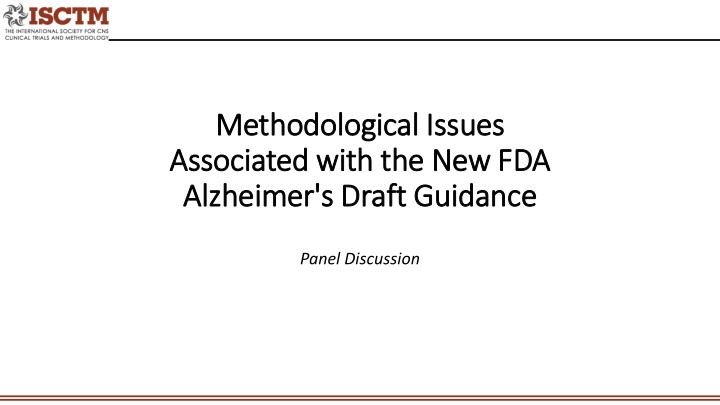



Meth thodological I Issues Associated with th th the New FD FDA Alzhe heimer's D Draft G Guidance Panel Discussion
Disclosures – Judith Jaeger • Owner, CognitionMetrics, LLC which over the past 4 years has provided consulting services to: • Acadia, Aptinyx, Astrazeneca, Axsome, Biogen, Boehringer-Ingelheim, Eisai, Forum, Iproteos, Ironwood, JnJ, Lundbeck, Otsuka, Pfizer, Sunovion, Takeda, Teva
Sessi ssion Hi Highlights: 1 1. C Clin inic ical T Tria ial En l Endpoin ints • ADCOMS is an empirically derived cognitive composite endpoints selected for maximal sensitivity over 12 months in “Early AD” • Limited to “the usual” AD trial variables (ADAS-Cog, CDR, MMSE) • Internal Eisai datasets plus ADNI • Progression on ADCOMS successfully allocated cases in a Bayesian adaptive randomization scheme to the most effective dose in a clinical trial. • PACC-R and EMACC are empirically derived cognitive composite endpoints selected for maximal separation of AB+ from AB- subjects over 2/3-5 years. • Natural history cohorts tested using standard neuropsychological test battery • High levels of consistency of which measures emerged as most sensitive to amyloid related decline • Some key differences between PACC-R and EMACC that emerge as a function of disease stage
Sessi ssion Hi Highlights: s: 2 2. C Case se I Identifi fication • STAGE 2 Definition: • Characteristic pathophysiologic changes of AD and subtle detectable abnormalities on sensitive neuropsychological measures but no functional impairment • Do such tests exist? (i.e. if neuropsychological tests are normally distributed, then by definition 16% of the normal healthy population will perform at – 1 SD without decline. 50% of the population can fall by 1 SD and still fall above -1 SD relative to population mean. ) • Use of innovative methods of longitudinal testing including burst test designs identify “decliners”. long run-in periods unless annual wellness exam standardized and available. • Emergence of subtle functional impairment • Is “subtle functional impairment” present if decline from superior to normal functioning has occurred? • The benefit of an informant report that change has occurred since some designated time point in the past. Promise from several informant report instruments sensitive to amyloidosis and disease progression.
Early A y Alzhei eimer’s D Disease: e: D Dev evelop oping D Drugs f for T Treatmen ent – FDA G Guidance of Indus dustry 2 2018 018 • Characteristic pathophysiologic changes (biomarkers) of AD but no evidence of clinical impact Stage 1 • Truly asymptomatic with no subjective complaint, functional impairment, or detectable abnormalities on sensitive neuropsychological measures • Characteristic pathophysiologic changes of AD and subtle detectable abnormalities on sensitive Stage 2 neuropsychological measures but no functional impairment • Emergence of subtle functional impairment • Characteristic pathophysiologic changes of AD, subtle or more apparent detectable Stage 3 abnormalities on sensitive neuropsychological measures, and mild but detectable functional impairment • Functional impairment not severe enough to warrant a diagnosis of AD
Recommend
More recommend